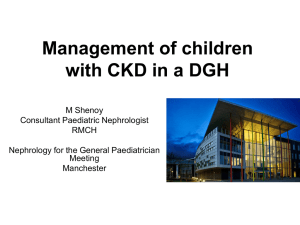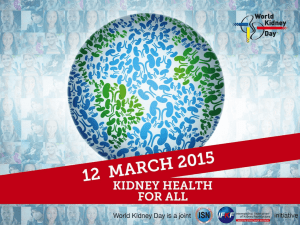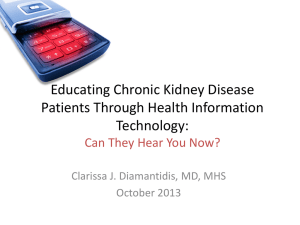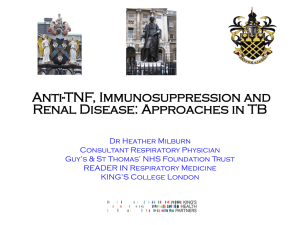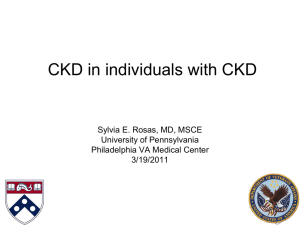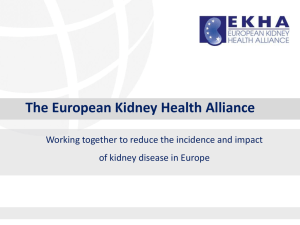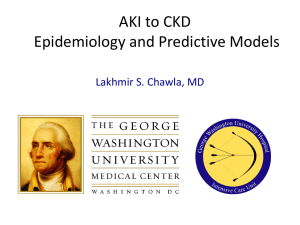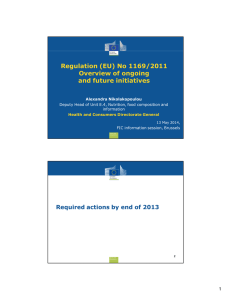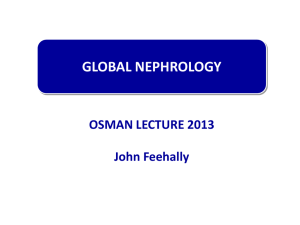CKD Controversy: how expanding definitions are
advertisement
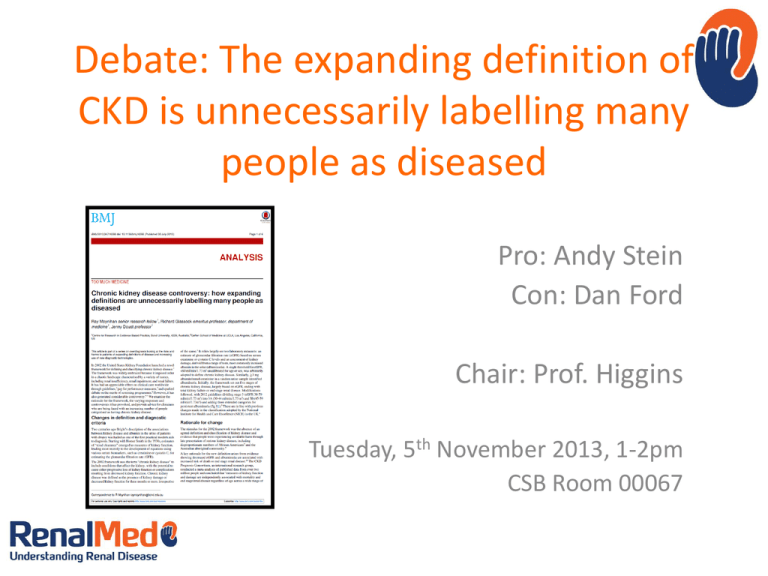
Debate: The expanding definition of CKD is unnecessarily labelling many people as diseased Pro: Andy Stein Con: Dan Ford Chair: Prof. Higgins Tuesday, 5th November 2013, 1-2pm CSB Room 00067 The expanding definition of CKD is unnecessarily labelling many people as diseased: Summary 1. 2. 3. 4. eGFR declines with age and is therefore “normal” Early identification does not prevent ERF Labelling people with “CKD” is a burden to the patient Labelling people with “CKD” is a burden to the nephrologist and GP 5. Chronic Kidney Disease is not really a Disease 1. eGFR declines with age and is therefore “normal” 1. eGFR declines with age and is therefore “normal” • Longitudinal studies of kidney function. – 33-41% of patients showed no decline • It may be statistically “normal” • It is no more physiologically normal than coronary atherosclerosis Baltimore longitudinal study of ageing. Lindeman J Am Geriat Soc 1985;33(4):278-85 Progression of kidney dysfunction in the community-dwelling elderly. Hemmelgarn KI 2006;69:2155-61 The expanding definition of CKD is unnecessarily labelling many people as diseased: Summary 1. 2. 3. 4. eGFR declines with age and is therefore “normal” Early identification does not prevent ERF Labelling people with “CKD” is a burden to the patient Labelling people with “CKD” is a burden to the GP and nephrologist 5. Chronic Kidney Disease is not really a Disease 2. Early identification does not prevent ERF • Early identification – Allows management of complications of CKD – Prevents progression of CKD – Reduces late presentation • Higher mortality, morbidity, hospital stay, cost (£30,000/year) • Due to poorer clinical state at presentation, lack of vascular access • No possibility of pre-emptive transplantation • Poor psychological preparation The expanding definition of CKD is unnecessarily labelling many people as diseased: Summary 1. eGFR declines with age and is therefore “normal” 2. Early identification does not prevent ERF – CKD is not just about preventing ERF – Clear association between CKD education (KDOQI, NICE, eGFR, QoF) and reduction in late presentation (~700 patients/year) The expanding definition of CKD is unnecessarily labelling many people as diseased: Summary 1. 2. 3. 4. eGFR declines with age and is therefore “normal” Early identification does not prevent ERF Labelling people with “CKD” is a burden to the patient Labelling people with “CKD” is a burden to the GP and nephrologist 5. Chronic Kidney Disease is not really a Disease 3. Labelling people with “CKD” is a burden to the patient 3. Labelling people with “CKD” is a burden to the patient 38: Samal et al. Routine dipstick screening 27: Crinson et al. Qualitative exploration of GP perspectives 3. Labelling people with “CKD” is a burden to the patient 38: Samal et al. Routine dipstick screening 27: Crinson et al. Qualitative exploration of GP perspectives 24: Spence: a bit of a rant in the BMJ The expanding definition of CKD is unnecessarily labelling many people as diseased: Summary ? 1. eGFR declines with age and is therefore “normal” 2. Early identification does not prevent ERF 3. Labelling people with “CKD” is a burden to the patient – Evidence presented is poor – Population at minimal risk of progression or complications of CKD (i.e. >70 years with stable eGFR 45-59) has already been addressed by NICE in 2008 The expanding definition of CKD is unnecessarily labelling many people as diseased: Summary 1. 2. 3. 4. eGFR declines with age and is therefore “normal” Early identification does not prevent ERF Labelling people with “CKD” is a burden to the patient Labelling people with “CKD” is a burden to the nephrologist and GP 5. Chronic Kidney Disease is not really a Disease 4. Labelling people with “CKD” is a burden to the GP and nephrologist Nephrologist 4. Labelling people with “CKD” is a burden to the GP and nephrologist GP – QOF • Register of patients with CKD • BP monitoring & control • Monitoring of uACR – Most with CKD 3: • IHD, DM, HTN, vascular disease • Already in “cardio-vascular” registers/clinics/QoFs The expanding definition of CKD is unnecessarily labelling many people as diseased: Summary ? 1. 2. 3. 4. eGFR declines with age and is therefore “normal” Early identification does not prevent ERF Labelling people with “CKD” is a burden to the patient Labelling people with “CKD” is a burden to the nephrologist and GP The expanding definition of CKD is unnecessarily labelling many people as diseased: Summary ? 1. 2. 3. 4. eGFR declines with age and is therefore “normal” Early identification does not prevent ERF Labelling people with “CKD” is a burden to the patient Labelling people with “CKD” is a burden to the nephrologist and GP 5. Chronic Kidney Disease is not really a Disease 5. Chronic Kidney Disease is not really a Disease 1. a disordered or incorrectly functioning organ, part, structure, or system of the body 2. any harmful, depraved, or morbid condition Is CKD associated with dysfunction or harm? • Reduced GFR • Albuminuria – Are both, independently, associated with increased mortality Nitsch D et al. BMJ 2013;346:bmj.f324 Summary: Burden of CKD guidelines 1. 2. ? 3. 4. 5. eGFR declines with age and is therefore “normal” Early identification does not prevent ERF Labelling people with “CKD” is a burden to the patient Labelling people with “CKD” is a burden to the GP and nephrologist Chronic Kidney Disease is not really a Disease Benefits of CKD guidelines • Reduced progression in small but significant numbers who progress to ERF • Reduction in late presentation to dialysis • Awareness of CKD – CVS risk management – Monitor for progression The expanding definition of CKD is unnecessarily labelling many people as diseased: No • • • • CKD is pathological, not statistically normal CKD is truly prevalent CKD is manageable A CKD label is a minimal burden to a patient provided it is communicated well • ERF is rare but harmful, burdensome and preventable • CKD guidelines have done considerably more good than harm Thank you “CKD Controversy: how expanding definitions are unnecessarily labelling many people as diseased” Moynihan R et al, BMJ 2013; 347 Dr Andrew Stein Consultant in Renal and Acute Medicine Ebers Papyrus (1550 BC) Why do new ‘diseases’ occur? • Some are genuinely new, eg – Bugs evolve – Humans evolve – Planet changes • Or, ‘created’ by confusion between causation and association .. and drug and technology industries, fuelling the capitalist dream (taxes, growth etc) CKD/eGFR a new disease? • Is it a new disease? No • Is it a disease? No • What is it? • Is it a good thing even if its all made up? 3 Possible Equations for eGFR • GG = (140-Age) x weight (in kg)]/72 x Serum creatinine (in mg/dL)* • MDRD = 32788 x sCr (mmol/L)-1.154 x age-0.203 x [1.212 if black] x [0.742 if female] • CKD-EPi = 141 x min(sCr/k,1)a x max(sCr/k,1)-1.209 x 0.993age x (1.018 if female) x (1.159 if black) So, how common is CKD? Age-specific prevalence of CKD. Prevalence of CKD for each age group by gender in 10,063 participants of the Tehran Lipid and Glucose Study (TLGS). Hosseinpanah et al. BMC Public Health 2009 9:44 Choices • • • Is Dan right? Ie, 60% pop > 70y have kidney failure Or not? Consequences of Adoption of eGFR/CKD concept • The adoption of this definition has resulted in more than 1 in 8 adults (almost 14%) in the US being labelled as having CKD • And as many as 1 in 6 adults in Australia Levey AS, Coresh J. Chronic kidney disease. Lancet 2012;379:165-80 Chadban SJ, Briganti EM, Kerr PG, Dunstan DW, Welborn TA, Zimmet PZ, Atkins RC. Prevalence of kidney damage in Australian adults: the AusDiab kidney study. J Am Soc Nephrol 2003;14(suppl 2):S131-8 100 consecutive UHCW medical take patients (Oct 2012) AKI/CKD 44% No AKI/CKD 56% What Happens to patients with CKD (not much) • Norwegian study (2006) surveyed 65,000 members of the general population with a median age of 49 • Less than 1% of people with an eGFR of 4559 ml/min/1.73 m2 (stage 3A disease) went on to develop end stage renal disease after eight years of follow-up Hallan SI, Dahl K, Oien CM, Grootendorst DC, Aasberg A, Holmen J, Dekker FW.Screening strategies for chronic kidney disease in the general population: follow-up of cross sectional health survey BMJ 2006;333:1047. Risk Factors not Diseases • • • • • Pre-diabetes Hypertension Hypercholesterolaemia Obesity CKD? Two ambiguities: – Causation and association – Is the carrier of a (possibly genetic) predisposition ill or not? What is kidney failure? Why Does Overdiagnosis Occur? • Screening • Increasingly sensitive tests (D-dimer) • Incidentalomas (things picked up on CT for another reason) • Widened definitions (‘pre-diabetes’) • Confusion between causation and association (CKD) Who developed this concept? • Kidney Disease Outcomes Quality Initiative under the auspices of the US National Kidney Foundation (2002) • The guideline that launched the framework was supported by a pharmaceutical company • “In the face of confusion and criticism of the potential for the framework to lead to overdiagnosis, specialist international meetings were held in 2004, 2006, and 2009 to discuss modifications” Other Diseases are Overdiagnosed (Hint: some may not exist) • • • • • • • • • • • Asthma — Canadian study suggests 30% of people with diagnosis may not have asthma, and 66% of those may not require medications Attention deficit hyperactivity disorder — Widened definitions have led to concerns about overdiagnosis; boys born at the end of the school year have 30% higher chance of diagnosis and 40% higher chance of medication than those born at the beginning of the year Breast cancer — Systematic review suggests up to a third of screening detected cancers may be overdiagnosed Gestational diabetes — Expanded definition classifies almost 1 in 5 pregnant women High blood pressure — Systematic review suggests possibility of substantial overdiagnosis High cholesterol — Estimates that up to 80% of people with near normal cholesterol treated for life may be overdiagnosed Lung cancer — 25% or more of screening detected lung cancers may be overdiagnosed Osteoporosis — Expanded definitions may mean many treated low risk women experience net harm Prostate cancer — Risk that a cancer detected by prostate specific antigen testing is overdiagnosed may be over 60% Pulmonary embolism — Increased diagnostic sensitivity leads to detection of small emboli. Many may not require anticoagulant treatment Thyroid cancer — Much of the observed increase in incidence may be overdiagnosis Attention deficit hyperactivity disorder • Diagnoses of children with ADHD have increased++, as have prescriptions for drugs to control it • Are they badly behaved children whom parents and schools cannot control • Or, do children behave badly because they have a disease that requires pharmaceutical intervention? Osteoporosis and Homosexuality – Diseases? • • • • • Osteoporosis, which after being officially recognised as a disease by the WHO in 1994, switched from being an unavoidable part of normal ageing to a pathology Homosexuality has travelled in the opposite direction through medical territory, and out the other side Redefined during the 19th century as a state rather than an act In the first half of the 20th it was viewed as an endocrine disturbance requiring hormonal treatment Later its pathological identity changed as it was re-categorised as an organic mental disorder treatable by electroshock and sometimes neurosurgery; and finally in 1974 it was officially depathologised, when the American Psychiatric Association removed it from the list of disease states in the Diagnostic and Statistical Manual IV What would convince me of eGFR/CKD thing? 1. “The incidence of the disease should increase in relation to the duration and intensity (dose) of the suspected factor 2. The distribution of the suspected factor should parallel that of the disease in all relevant aspects 3. A spectrum of illness should be related to exposure to the suspected factor 4. Reduction or removal of the factor should reduce or stop the disease” Lilenfeld, A. M., On the methodology of investigations of etiologic factors in chronic disease. Some comments. J. Chronic Dis. 10, 41 (1959) So what is eGFR/CKD thing? • • • • • • • • A new disease? No A disease? No A confusion between causation and association? Yes A concept created with the best of intentions? Yes Fuelled by the drug and technology industries? Yes A risk factor? Possibly A genetic predisposition? Possibly A ’good thing’? Possibly If you go looking for Zebras .. Thankyou!

